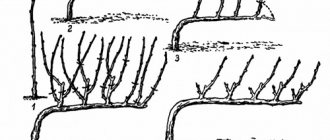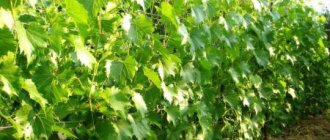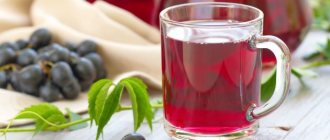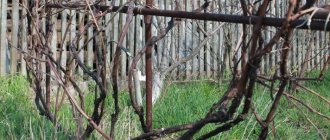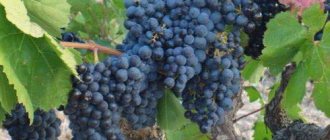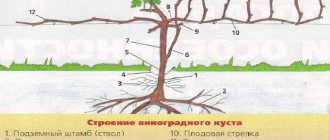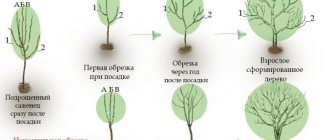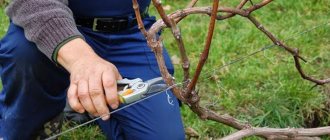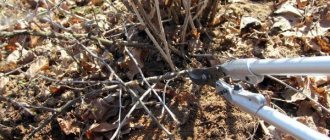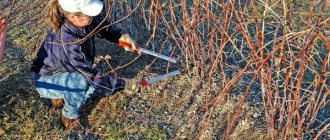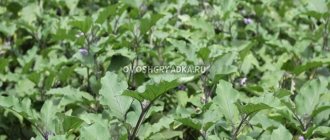Rules for forming a grape bush
What it is? - This is giving shape to a grape bush. With the help of proper pruning of vines, light gartering, timely pinching, pinching, chasing and other green operations. The culture of growing grapes influences the method of formation. It depends on the zone in which the vineyard is grown.
They are divided into: uncovered grapes – optimal formation – standard bush;
semi-covering - a combined form is used in which the lower level is covered;
covering - it is advisable to use fan-type formations located low to the ground.
Typical mistakes when pruning bushes
When pruning grapes, beginners often make mistakes that reduce the yield and gradually lead to the early death of the bush. In this case, the plant gets sick before it has time to reach the level required for the harvest.
Find out how to properly prune grapes in spring.
For beginning farmers, here are the most common mistakes when pruning a vineyard:
- Incorrect determination of the cutting length of stems of different ages. It is necessary to exclude the harmful effects of transverse and longitudinal polarity (uneven growth of stems). Therefore, during the spring shaping process, keep in mind that the length of the cut part depends directly on the thickness of the stem. The thicker it is, the longer it should remain after formation.
- Feeling sorry for the young bush, inexperienced winegrowers shorten the tops and get rid of dried branches. Although it would be correct to cut off the lion's share of the growth. The result of such a gross mistake is the intertwining of branches among themselves. And for the next few years, the branches block each other’s rays of the sun. Fruiting stems lack nutritional elements; they form small berries, devoid of bright taste and aroma.
- Incorrectly assuming that thick stems are more durable and will give a larger harvest in the future, beginners cut off young specimens. It is the thick shoots that need to be pruned.
LAWS OF FORMATION
If you understand the principle of one formation, then you can perform any form suitable for your zone. To do this, you need to understand the following.
“HER-HINGING ART” RULE:
the grapes send out branches over the entire area of the branch. Any bud can produce a new stem.
The survival rate of buds depends on their planting area.
In cold regions, only up to 50% of the buds survive, and in southern regions - up to 100%. When the shoot is tilted, a “herringbone” visually grows. And if the branch is positioned horizontally, then the shoots visually look like a “comb”.
Here you need to remember these abilities of grapes. 1: If the bush is not pruned, then the annual growth of new branches can reach up to 10. And, therefore, the more shoots, the weaker and thinner they are. Every vine is trying to bear fruit.
Therefore, many varieties can destroy themselves if they do not know how to get rid of excess shoots. 2: To maintain the strength of the bush and its shape, you need to regularly reduce it.
When pruning, we save only one branch in each “Christmas tree” or “comb”, the so-called replacement. 3: In order to create a shape, you need to trim off unnecessary shoots.
Because The vine has the property of branching, then it will not be difficult to perform the necessary action from it:
- form a new sleeve,
- make a branch of the horn there,
- where necessary, extend the sleeve.
The bush develops only those shoots that we left. It is also necessary to understand what polarities are.
VERTICAL POLARITY
this is when the bush grows upward. The strongest buds are located at the top. They are the ones that give the strongest shoots. The lower kidneys are the weakest, they may not even wake up. The upward-pointing branches sprout shoots, usually from the last two buds. The lower area becomes bare. If you want to lengthen the shoulder, you need to tie the end higher.
If it is necessary to divide the vine, then give it a horizontal position. The replacement site is the highest point on the shoulder where strong shoots grow. If you bend a branch or shoulder down, the strongest branches will grow at the top of the bend.
A good way to grow replacement arrows or arms without cutting them off first. A young bush is just a weak vine that needs to grow for another 2-3 years and develop wood and root systems. It does not have the strength to bear fruit abundantly and needs good shelter for the winter.
IMPORTANT!!! During the first years, take care of the growth and formation of the bush, protect it from frost, disease and harvest.
Choose only strong vines to give the correct shape. Point them upward. And it’s better to just pinch off the remaining ones.
After all, the larger the green mass, the more powerful the bush grows its root system.
Basic conditions for choosing a formation scheme
The shoots are cut according to certain patterns. Several options for removing branches of grape bushes have been developed and put into practice. The choice is determined by:
- the climate of the area where grapes are grown;
- soil type;
- speed of shoot development;
- the main characteristics of a particular variety;
- the need for shelter for the winter.
The parameters of accumulation of woody mass of bushes and soil fertility are taken into account. On poor soils where there are problems with watering, bushes with a small number of sleeves are grown. For fertile soils with abundant watering, any shape is suitable, including those with numerous sleeves.
In cold regions, grapes require shelter in winter, so they choose the most suitable schemes for bending down the shoots. In central Russia, where winters have little snow and strong winds often blow, bushes are covered entirely. In the northern regions (Urals, Siberia, North-West) winters are colder and longer, so they practice their own pruning methods.
What types of vineyards are there?
The bush can be MULTI-ARMED, or fan-shaped.
His shoulders can be both short and long. They are intended for trellises or. They are usually formed for gazebos and arches. The standard can be different, from high to completely absent.
Also the shape of the bush can be
Fan Short Sleeve
It is important to be able to correctly distribute the branches of the sleeves and not thicken the bush.
Cons: the bush is limited in the development of its power.
A small supply of woody vines.
It is inconvenient to cover the bush due to the large number of horns.
The location of bunches and shoots close to the ground promotes the development of diseases.
When caring for a plant, you must bend down.
Plus one: I usually use this formation in cramped and low-lying places. Although it is better not to use this arrangement for growing grapes.
For gazebos, as a rule, a molding is used
Gazebo Long Sleeve Fan
The bush grows only along the perimeter of the gazebo area.
The fruit links are evenly distributed over the support.
The bush has a lot of wood. It is convenient to care for the bush. When covering, it is easy to lay the vine on the ground.
Due to the fact that the shoots and shoulders that are located higher grow more strongly over time, they take over the bush.
The lower shoots become weaker and become bare.
Fan shape of bushes
involves 2 or more shoulders, which are arranged in the shape of a fan relative to the level of the trellis.
There are no stamps for such formations.
There are short fan designs with 2-4 small sleeves. As a rule, their length 3 is from 30 to 40 cm, 4-6 shoulders are usually medium. Their length is approximately 40-60 cm. Large - the sleeves can be about a meter or more long.
Forming without standard multi-sleeve fan
Number of sleeves: 4 to 6 pieces, the length of which reaches from 40 to 60 cm or more;
the shape of the bush looks like a fan, the shoulders are inclined towards the ground.
In this method, 1-2 replacement branches are left.
Types of grapevine prunings
There are several types of pruning, among them the following stand out:
- forming pruning;
- annual pruning;
- pruning neglected vines.
Formation of a standard-free fan.
Formative pruning is performed from the beginning of the growth of the future fruit-bearing bush. It gives shape so that the plant develops correctly.
Already formed bushes undergo annual pruning. This is done in order to replace the fruiting links with younger ones and the tree does not lose its shape.
Pruning a neglected vine is a rather controversial action. It is better not to renew an old bush, since this process will take a very long time and may not give the desired result; it is better to use it as a mother shoot for obtaining new grape seedlings.
How to properly form a four-armed grape bush
Year I: Planting a seedling - the last eye should be at ground level
We grow one or two vine shoots
We do not prune in the fall. We cover the branches for the winter, preferably by burying or covering them.
Year II: Spring – young shoots are pruned after opening
Select the two strongest shoots and cut them into 2-3 buds. The rest are removed to the ring
During the season it is necessary to grow 4-5 strong shoots for further formation
IMPORTANT! Make sure that the top eyes on the knots are as close to the ground as possible. This will have a beneficial effect on the winter shelter of the fragile bush.
In the 1st and 2nd years of growth, it is necessary to promptly carry out catarrhosis and remove excess growth.
The trellis is installed by the spring of the second year of the seedling. We tie the vine at an angle, spreading the branches to the sides.
Don’t forget to leave one or two replacement knots and break off the rest of the vines.
Autumn: cut off the sleeves. Divide the distance between the bushes in half. And, visually, we prune up to this point so that two adjacent bushes do not overlap each other.
We leave only a strong strong vine for two or three buds.
If there is one strong shoot on the bush, then it must be cut to the length of the sleeve. Weak shoot - 2-3 eyes per twig.
If three developed shoots have grown on a bush, then two sleeves are formed from the top two. Leave 2-3 eyes on the bottom one.
If you have four mature strong shoots, you can immediately create sleeves, leaving the desired length. Sleeves that are on the outside should be longer than the inside ones.
III year
Spring. We form the missing sleeves. To do this, the young shoot is pinched when it reaches a height of about 10 cm. 2 buds are planted.
Then, from the grown young vines, the strongest and most mature ones are left.
We leave 2-4 upper shoots on the sleeves, break out the rest.
IMPORTANT!!! The lower shoot should be located outside the bush to form a replacement branch for the next year.
Autumn: creating fruit links. On the outside of the bush we leave two or three buds for replacement branches, and one shoot from above - for 5 or 6 eyes (fruit arrow).
IV year: Autumn. The formation of fruit links is completed. Further pruning is done only at the fruit links.
Reinforced fruiting links can be formed by leaving not one, but two fruiting branches.
An accelerated method for forming a standard-free fan shape
In the second spring, 4-5 most developed shoots are left. By pinching and pinching, I form the desired length for future sleeves. The rest of the growth is removed.
In the fall, we prune by 2-3 eyes, leaving the outer branch for a replacement branch. We remove excess growth.
Third year, spring: you need to remove all the shoots that have developed on the sleeves.
The shoots of fruit shoots and replacement branches are left. To create restoration branches, you need to leave 1 or 2 shoots on the head of the bush.
This formation makes it possible to obtain high grape yields annually, and is also easily restored.
One-sided fan shape of the bush
Distributed in the sheltered growth zone of grapes in industrial vineyards. Peculiarities:
The sleeves with this shape are directed in one direction.
The bush consists of 3 or 4 sleeves
The length of the sleeves is different: from the longest (Lower) - 120 cm, with each subsequent sleeve decreasing by 20-30 cm.
The shoots are distributed evenly on the trellis.
Disadvantages of formation: bunches are too close to the ground.
FAN FORM ON STAMP
Used for covering bushes on arches and gazebos. They cannot be covered, because The bush is very branched and the trunk practically does not bend. The bush has many tiers and the lower ones are already bare.
MULTI-STOREY GAZEBO BUSH – used to create shade in a gazebo by entwining shoots around the walls of the structure. The bushes are very strong. The increment is distributed evenly throughout the support.
The vine is perennial, very woody. The largest clusters grow on such strong bushes.
Problematic in cover. Either they hope for a warm winter, or they roll the vines into rings. Wrap it with insulating material and leave it on the support.
Such a bush is very difficult to preserve. The bush has horizontal shoots that are located closer to the trunk and shoots at the end of the vine that grow more powerful than others.
Vertical shoots: the strongest vines form at the bend of the arbor, drawing all the strength onto themselves.
Therefore, it is important to regulate the balance here - direct the lower growths upward so that the lower tiers do not weaken, and adjust the load on the bush.
Long-sleeve One-sided uniform (Sh.N. Guseinov)
This form involves a trellis with 3 tiers.
In the second year, at the beginning of the season, you need to fix the first level of wire on the support at a height of 15 cm.
At the beginning of the formation of grapes (2-3 years), it is necessary to give the bush a Z-shaped appearance.
To do this, the bases of the long arms need to be tied to the bottom wire.
Upon reaching the fourth year, it is necessary to raise the lower level to 65 cm in height. Set the remaining two tiers at 125 and 165 cm, respectively.
Moreover, the second and third levels consist of two parallel installed wires.
This formation assumes the presence of 1 to 3 shoulders.
- The shoulders reach a length, usually from 1 to 2 meters.
- Each sleeve branches into 2-3 vines.
- In total, a bush can have from 6 to 12 fruit vines.
- Replacement branches – 2-6 pcs.
- Sleeves need to be rejuvenated once every 3-4 years.
- The Z-shaped bend facilitates the work of covering for the winter and laying bushes.
- Green fruiting branches that can hang freely between the rows. It is not necessary to tie it up.
Pros: Good ventilation of the bush, reduced risk of berry diseases.
Method of combined formation of grapes for semi-covered viticulture zones
Areas of use: there is a repetition of low winter temperatures, the consequence of which may be freezing of uncovered areas of the bush.
The form has the following form: a support that is not covered for the winter period, the height of which is up to 115 cm.
In late autumn, the shoulders of the cordon with fruit links and the near-earth link are covered.
Ground links must be grown near the trunk. They consist of a long vine, a horn and a replacement branch.
II year. Spring. The most powerful and mature vine should be left for further shaping. It is cut into 2-3 kidneys.
The escape is developing. Then two of the developed vines are left.
The first is that a sleeve is formed on the trunk, another vine will be located below and form a fruiting link.
III year. At the beginning of the season, the top vine is pruned at trunk height. The lower branch is shortened to 2 or 3 buds. At this time, the top two branches on the trunk are broken off. They are used to create cordon shoulders with fruit links. The vine located below is cut into a knot. While the vine, which is cut from above into a fruit branch.
Length - 7-8 buds or more.
Peculiarities
The bottom link needs to be tied. Tilt the wire horizontally to the lower level (height approximately 0.35 m from the ground). When the bushes are pruned, the branch located below is covered together with the trellis wire.
The fruiting arrows (lashes) of the lower link are removed every year. Instead, new arrows are formed that have grown on the replacement branch. Young arrows that have developed on the fruiting branch and the replacement branch are placed on the upper floors of the wire.
If there is significant damage to the buds at the upper level, the load on the bush can be increased. By increasing the vines of the lower level or by forming a stronger fruit unit. How are the trunks formed? And it's very simple. Annual vines grow on the ground links.
Every year, old trunks are cut off by 10-15 cm. One-year-old vines are tied vertically to the trunk in a vertical position, and new sleeves (cordons) are created from them. The lower link is again created on vines that grew on the left branches from the cut old trunks
Forum statistics
207036 Messages in 1634 Topics from 5593 Users. Last user: Amaya Last message: “Let's talk about the weather in Vash...” ( Today at 07:52:22 ) Latest messages on the forum.
Now on the forum
34 Guests, 10 Users
Users in the last 15 minutes: 64nikolay64, Marshal, therapist, Svetla777, Liza, lomakin1969, Alexander Vl., Elvira2017, Andrey76, Slavka [Blocked] [Section Moderator] [Forum Moderator]
Maximum online today: 77 . All-time maximum online: 2758 (28 July 2021, 17:22:51)
Users who visited the forum in the last 24 hours
Total: 295
(Visible: 294, Hidden: 1) 1963, 64nikolay64, Marshal, Svetla777, therapist, Liza, Capricorn, lomakin1969, Alexander Vl., Elvira2017, Andrey76, Slavka, Mikhail77, ElenkaF, Tatyana B, Alex65, Cherkessk, Eugene, zsb, Leonidych, vladimirM, yotmast, mers, Serg1707, SNovichek, hanter64, znakomij, Alexander K, Vardan, Sergey Fer, Anatoly Sivkov, Alexey V, Ilya 77, Andrey Gladilin, Tatyana A., Belgorodets, in Astrakhan, Oksana Kopp, sem_en, Vladimir 153, skier, Igor Viktorovich, slavalimon, Primorets, OlgaOs, SANYCH, 31rus, mystic69, DorontsovPeter, Andrey Tsvetkov, Buba, igor222, Elena Z, vlad51, Kenig, Nikolay Rex, Sergey 1965, Vladimir Buturlakin, DSW, psv1960, Dmitry 77, Vasily V., Vyacheslav03, Natalia Nikolaevna, Sergey Tashchiyan, Nikolay S., Igor Sergeevich, alexsandr, kvg, Pioneer, Ekaterina Polyanina, nicson7, Elena Aleshchenko, Alexander-ask-34, Verona, Igor F., Taker, Tikhii , Henry, Yuri72, L.A.P., Gaivoronsky Yuri, Sergeevich, Sergei Chistokletov, Svetlana Streletskaya, Galinka, Alexey Deminov, Naumov Igor, Vyacheslav136, Gloomy, Katrin, AndSanych, Mikhno Alexander, Ded31, Filippov Oleg, Vladimir ++ , Mikhail Alekseevich, Lydia58, ALEXANDER BRYANSKY, Vladimir-kanevskaya, DIL, Amber7394, Marina Protasova, TITOVA LYUBOV, Linx, alexander66, Natalya M, Mikhail Fesenko, Amaya, Alexander71, Boris 1952, tsv, Maximilian, 25nata35, nadia, GALINA A NOKHINA , Igor_K, Alexander Kolesnikov, Ivan Levin, Pitko, weather forecaster, eSAa, cecet71, atseton, Alexander Smirnov, Vladimir Kostochkin, Vladimir Berdnikov, Gocha, pioneer-2, LeXa_KoT, Sergey 61, Sergey Yuryev, Erem, alexss, Evgeniy52, Skif, Vladimir Kovba, dayton, Yuri Semyonov, N.A. Sokolov, Pavlentiy, Sa-shura, Volgogradka, Dmitry Anatolyevich, Grandfather Igor, Andrey Lis, Bublichenko Alexander M, Marina Krymskaya, stenlly2010, irahelm, Vyacheslav Vladimirovich, Vladimir Shilov, Aprel, Badaev Dmitry, gheo55, Yura, y_fed, rambo, Yagodka, Valentina Ivanovna, Kryn, oleg9f, DED2, Svetlana Korotina, Zavezen Oleg Ivanovich, Eduard., santra, L2k2m7n, Alexander48, Viknik, Andrey 31, m2d, Valery Rastorguev, Soshnin Yura , Amateur gardener, Galina, Vasily1111, gardener, marlin64, Salex, sergei, Sergey Ko, Ramiz, viktor_, kosmos, potap05, Yuri 36, VitalySD, Inna161, Vova Kapran, Vladimir Shcherbinin, Valerie, niy1, cfibr, Andrey68, kulol3 , thanatos, Serzh1978, Realist, Artur53, max2008-01, LOZA, AlexanderD, Grandfather Young, Natasha, Zayac, ketch, Rita, alx-74, Iv Iv, Alexander150, Igor K, Vasily Viktorovich, VeraNiK, kdm57, Veniaminovich, Boris Sokolyansky, 77volt, , vikbublik, neposny, Evgen, Victoria Aleksandrovna, Serezha 64, Wintel, Airbone, teri, Sergey Lomonosov, Khramov, serginio, Leonty Yarygin, Irina O., Ser, Nadezhda Grig, Lyubov S., netolya, Saisan, Agryzkov Alexey, Vadi, Zinaida, Vadim, Alexander Taganrog, Sukhonos Sergey, Snezhinets, evgen_26, nau_63, Masha_gardener, Gennady163, krasnovlad1, Alexander Zinoviev, Vasily 53, Roman Fedorovich, TIS, Alexey Sergeevich, arnyusha, Zheka, Nurtas, kradievska, nick041 , Valentina Medvedeva, Sergey43, Andrey S., Nikolay Lipunov, Mst, Vertuoz2, Vladimir VS, NatalyaMed, freesia, Kinna, Mikhail Michurinsk, alekcsan1, VALERY TAMB, Sasha57, MikhAf, Y_Azer, Andrey Beribesov, hunter1955, nut lover, Keys, Ivan Shmelev, Pestik, anton_slash, Nadymchanka, Sergey 31, Volgar, Pavel 64, Tatyana Volzh, Elektronik_t, Alexander 61, spotlight, Alexander Guy, Cheprak, Pirko Alexander, vladimirvrn
Formations for uncovered viticulture
They are more popular in the area of uncovered vineyard cultivation.
High standard cordon formations
Cordon is a shaping method in which the sleeves (shoulders) are formed over the years in the shape of a cord of an elongated line (a cordon can be visualized as a cord). This is a feature and difference of this formation. What types of Cordons are:
Horizontal cordon - the standard is located elongated, parallel to the ground.
Vertical cordon - the standard is placed vertically to the soil surface. Depending on how the Cordon's slope is positioned relative to the ground, it can be either inclined or oblique ( possibly covering).
Types of Horizontal Cordons
one-sided and two-sided
, the sleeves are parallel to the ground. Fruit links and replacement branches are placed at a certain equal interval. The type of formation of this Cordon is a high trunk with two shoulders. The height of the trunk varies from 1 to 1.3 m. The wire on the support can be arranged in 2-3 tiers, while
The first tier is at the height of the trunk; fruit branches and cordon shoulders are attached to it.
The second level is located at a height of 30-40 cm. Green arrows are placed on it, which will then hang down into the aisles.
If you want a trellis with three tiers, then the second tier must be placed at a height of 20 cm from the top tier.
Subsequently, you need to attach long arrows there. The wire of the third level is located 35-40 cm from the second. Green shoots that will further hang into the aisles are attached to it.
Formation Disadvantages
- this formation forms a “tent” of greenery, which impairs the effectiveness of pest control and bunch diseases;
- because the lower level of the shoots is poorly lit - crop production in this zone is low;
- Mechanized harvesting often damages the buds that bear fruit the following year.
Year 1: We plant the selected varietal seedling. Cut into 2 buds. Water generously.
During the season we carry out catarrh and remove the shoots.
Year II: We install the support in the spring of the second year. It should not exceed 1.80 m.
Sleeves (cordon shoulders) are created by
1) Pasynkov. To do this, in the second year, shoots are cut off at the level of the future trunk. If the vine has grown only to the level of the trunk, then the crown is pinched, stimulating the growth of the upper stepsons.
After a week, you need to leave the top 2 and cut out the remaining stepsons. These will be the future sleeves. They now need to be laid along the wire, in different directions.
2) from the upper wintering eyes of an annual trunk. We can form one sleeve from the main vine, bending it along the wire.
We will make another from stepsons, or a vine that has developed from a wintering bud.
Scheme
Spring: the most developed stem is cut into 2-3 buds (before the vineyard begins to bloom), at the same time it is necessary to carry out catarrhization.
When the branches have grown by 15 or 20 cm, it is necessary to cut them off and leave only 2 shoots - for trunks and for replacement.
The shoots are gradually tied to the trunk.
III year
The bush has good cordon shoulders and an even trunk. In the spring, when the shoots reach a size of 15-20 cm, it is necessary to break off the excess shoots.
At the same time, we cut out all the vines that appear both on the bends of the sleeves and on the trunk. Shoots must be normalized at a distance of 20-25 cm from each other.
The first shoot from the trunk should be located approximately 10 cm.
During their growth, we tie the shoots to the wire of the upper levels. Otherwise, the bunches may end up on the ground.
IV year
At the beginning of the growing season, the shoots left under the horns are pruned. Leave 2 buds from the base. The top bud should face inward.
If the first and second eyes look outward, then we leave the third bud, which looks inside the bush. This is how we create a replacement knot. In spring, the length of the bush is also formed. The shoulders of two adjacent bushes are trimmed so that they meet.
V year
In spring, fruit sleeves form a cordon. We cut the replacement branch into 2-3 buds, and the fruit shoot from four to eight buds (varietal characteristics are taken into account).
We tie arrows with a length of more than 5 buds to the second level of the trellis in an arched manner at an angle.
Next, you need to trim the bush as standard, i.e. fruit arrow plus replacement branch. You cannot spirally wrap the sleeve around the wire, because the branch will thicken further. She will dig into his flesh. The garter should be loose and not interfere with good sap flow.
Advantages
Siberian winegrowers most often form grapes using a single-armed or double-armed cordon with a recumbent, horizontally rising trunk.
This cordon has a large supply of wood, it is convenient to lay it and raise it to any height. It seems to me that cordon is the most effective forming method for winegrowers of any level.
Common types of grape shaping
Fan formation
Suitable for covering grapes. With this type of shaping, 4-6 sleeves are produced. They are evenly tied with a fan to the trellis. One fruiting link is formed per sleeve.
The fan shape of the grapes allows you to cover the plant for the winter
The advantages of this formation:
- greater plasticity of the grapevine;
- promotes rapid recovery of the vine after damage to the sleeves;
- good ventilation and lighting of the vineyard;
- you can rejuvenate the sleeves, and the yield will not suffer.
- It’s easy to cover the vineyard for the winter.
Flaws:
- grape clusters are located close to the ground, so the risk of powdery mildew and gray rot increases;
- the vineyard is easily overloaded and cannot always provide nutrition to all the formed grapes;
- the berries of a bunch of grapes are small and their ripening is delayed;
- plants begin to lag behind in growth and development, and the risk of various diseases increases.
Half fan formation
Another name is one-sided fan formation. Combines the advantages of fan molding and the simplicity of cordon. The sleeves are directed in one direction.
Semi-fan formation combines the advantages of fan and cordon formations
Advantages:
- shoots are evenly spaced on the trellis;
- no thickening;
- It’s easy to cover for the winter.
Cordon formations
A common feature for all types of this method is the presence of a long-term long sleeve. It can be located obliquely, vertically or horizontally.
Oblique cordon, or cordon slope. It has one perennial sleeve directed upwards. From 3 to 10 fruit links are formed on it.
Oblique cordon - a simple way to form a grape bush
Advantages:
- Cordon perfectly accumulates nutrients;
- grape clusters are located 50-150 cm from the soil, well ventilated and illuminated;
- the risk of disease is minimized;
- ease of covering for the winter.
Flaws:
If you lose a sleeve, you may be left without a harvest for several years.
Double-armed cordon. Suitable for low-growing varieties of covered grapes and for varieties that do not require shelter. The grapes are formed into two opposite arms of the cordon. They are located on a low trunk (about 15 cm). For non-covering varieties, the shoulders of the cordon are placed at a height of 40 cm. Each shoulder is formed at 50-70 cm. On them, every 15 cm, permanent horns are formed with a replacement knot (2-3 eyes) and 2-3 fruiting arrows (5 eyes each) .
Double-arm cordon is not suitable for tall cover grapes
Advantages:
- ease of care;
- if one shoulder dies, the harvest will be on the other;
- rapid growth of strong shoots.
Flaws:
not suitable for grape varieties that require shelter.
As you can see, each type of formation has its own strengths and weaknesses. The choice is yours!
Formation of bushes using the Guyot method
This formation is quite common among winegrowers.
Advantages of this method
Shoots on the replacement branch and on the fruit links develop very actively and are most developed;
If you properly tie the fruit branches, you can ensure a high bunch weight;
At the bottom of the bush we leave a replacement branch with 2-3 buds. It produces good strong shoots and the sleeve gradually lengthens.
The essence of pruning: it is important to form a healthy, regular horn, which will have all the cuts on the upper side. Those. the branch needs to be cut into a replacement branch, into 2-3 buds, depending on their location.
It should also be placed in the direction of the future bend of the fruit branch.
The Guyot forming method is used, as a rule, for varieties that do not require short pruning. Although in practice, a slightly modified double (two-armed, double-sided) Guyot trim is more often used.
Those. the trunk has two short fruiting arms opposite at the same level with fruiting links. This makes it possible to double the load on the bush.
One of the varieties of Guyot forms is also a form - without a bole, with an inclined bole.
High-standard double-shouldered twisted cordon with twisted standard
With this method, the formation of the bush is usually completed by the 4th year.
You need to plant one-year-old grafted seedlings with good roots. Planting scheme: Plant bushes every one and a half to two meters (weak and medium-growing), vigorous ones - 200-250 cm, make rows every 3 - 3.5 meters.
Disembarkation time
from March to April or November, vegetative seedlings are planted from mid-May to June in prepared holes. I year. A pair of shoots are grown, each of which has 2 eyes. There is no pruning in autumn.
II year. Spring: when pruning, leave two branches with two buds. After the bush blooms, 2 normal shoots are left, the rest is broken off. They are formed vertically, relative to the trellis.
III year. In spring, before the active development of greenery begins, the shoots are cut off at a level of 125-150 cm from the ground and intertwined into one twisted trunk.
When the buds have blossomed, you need to cut out all the shoots from the bottom, leaving only the top four. In autumn. Visually divide the distance between the bushes in half and cut the vines a little more than half of this mark. We intertwine them in pairs with each other in the shape of a braid. Thereby creating two shoulders of the cordon. We place it parallel to the ground, in opposite directions from the twisted trunk.
If the bushes are located every 2.0 m, then the load on each twisted sleeve is 25 - 30 buds, respectively, per bush - 50 - 60 buds.
IV year. During this period, the fruiting branches hang freely. The shoots on the trunk are removed. Each subsequent season the bush is pruned into a branch with 2 buds.
Advantages of this formation
Wood accumulates at an accelerated rate due to the twisted trunk and twisted shoulders; The formation is simple; Optimally balanced for load; Begins to bear fruit early, high productivity.
Columnar shape of the bush on a wireless support
It is used in the area of uncovered viticulture. The method reduces labor costs. Convenient for pruning bushes. Does not require the cost of a trellis.
To form a columnar shape without a trellis on a support without wire, use the following scheme: A plot of 2.5 by 1 m, or 3 by 1.5 m. The planting of the vineyard is carried out with vegetative seedlings. In the spring of the second year, dig stakes 1.5-1.7 m high After the buds have blossomed, it is necessary to break out all the shoots. Leave the 2 strongest ones on each bush. The vines are wrapped in a spiral around the standard stake throughout the entire growth period.
The first is clockwise, the second is counterclockwise. Until the very end of the stake. Next, they are secured and the trunk is made in a vertical position and the cordon shoulders are made in a spiral. In the spring of the third year, each vine is pruned at the level of the trunk. During the summer period, shoots developing on the trunk of the support column are removed (up to 1 m).
The shoots formed on the vertical shoulders-cordons above the trunk are left, form short horns and twist spirally around the support.
In the fourth year, the vines with grapes branch evenly and freely around the support.
As a result, only short pruning is used in the following years.
In the Medium, with a given bush formation, the load is approximately 40 buds.
